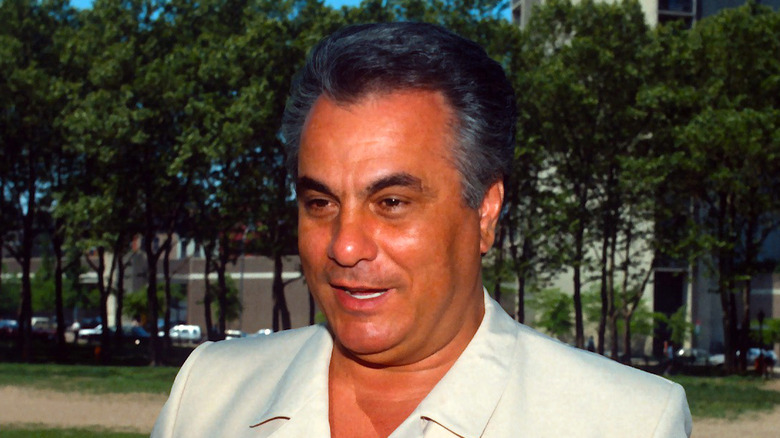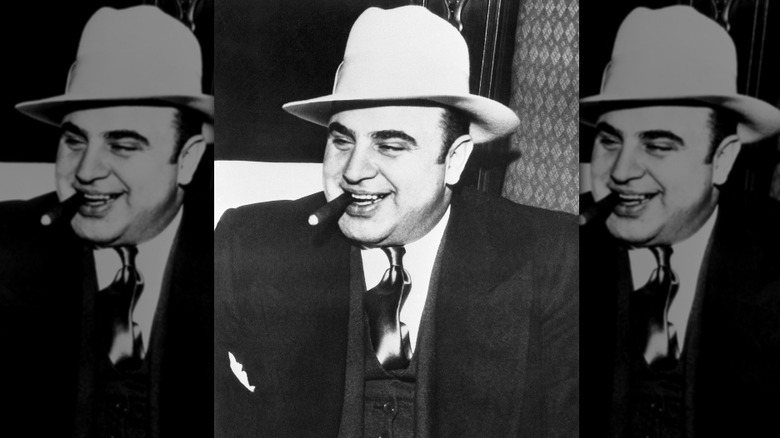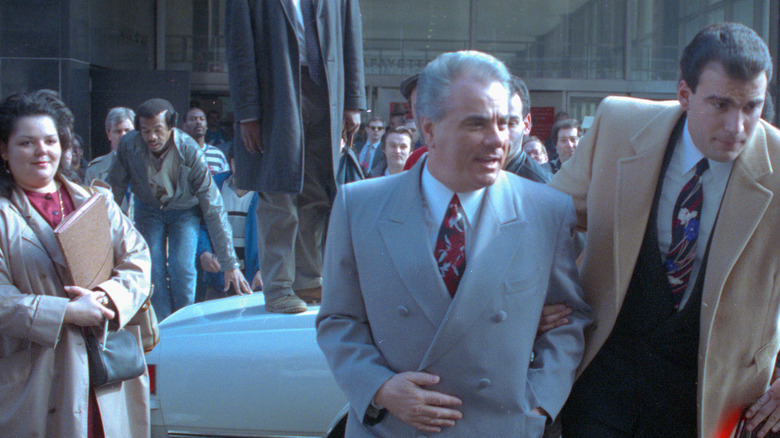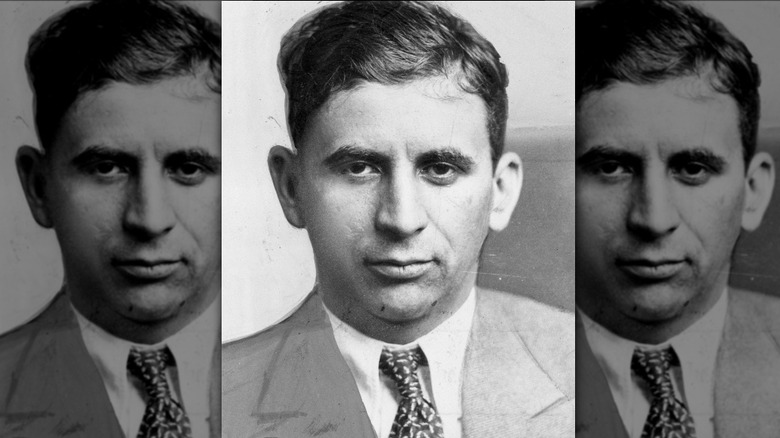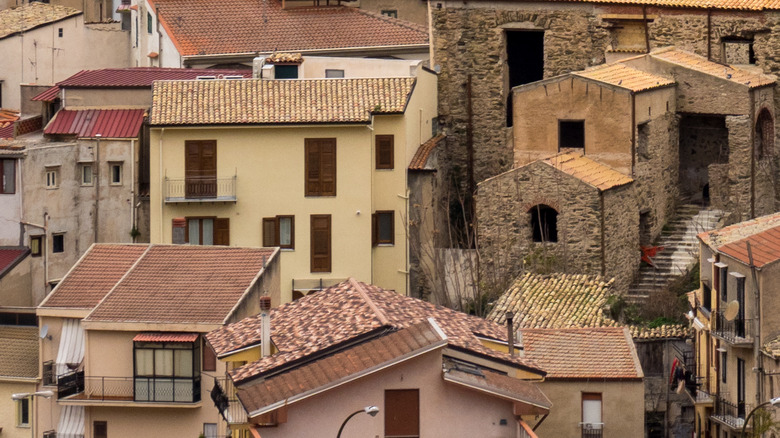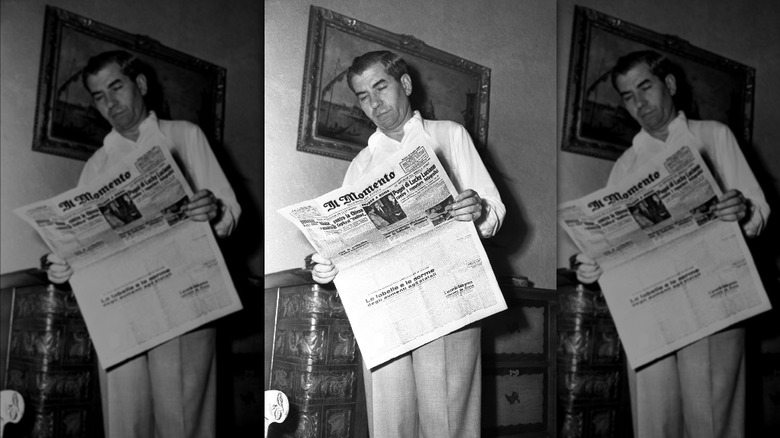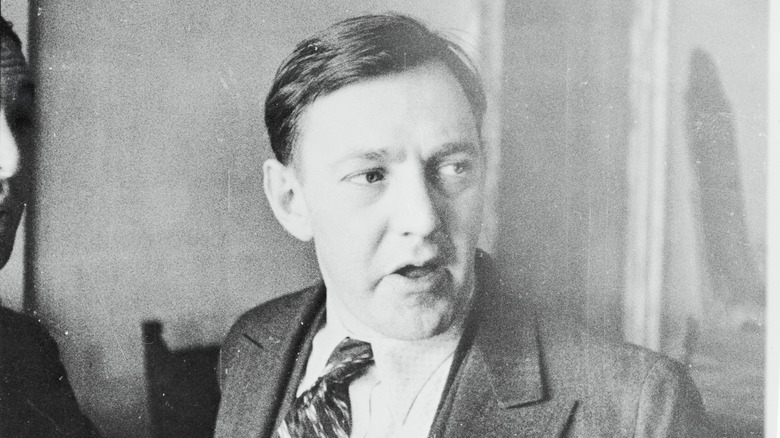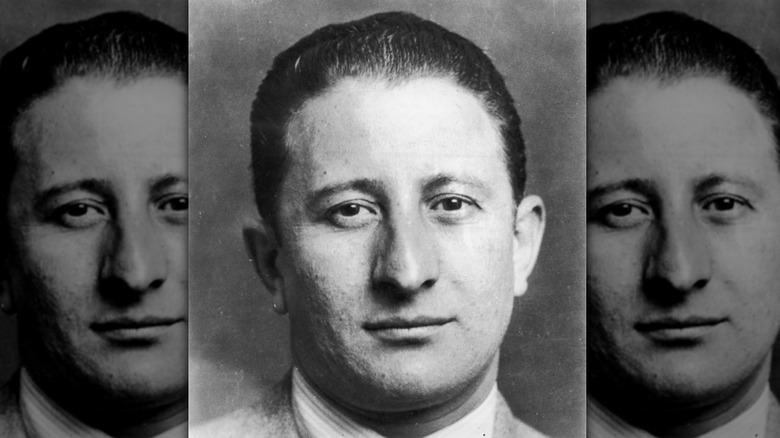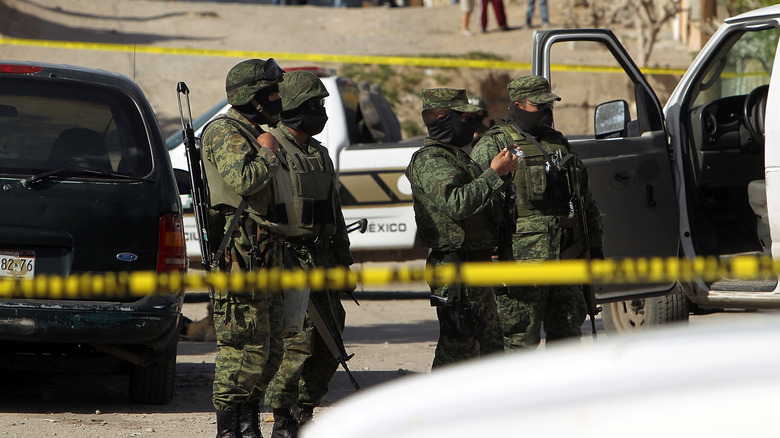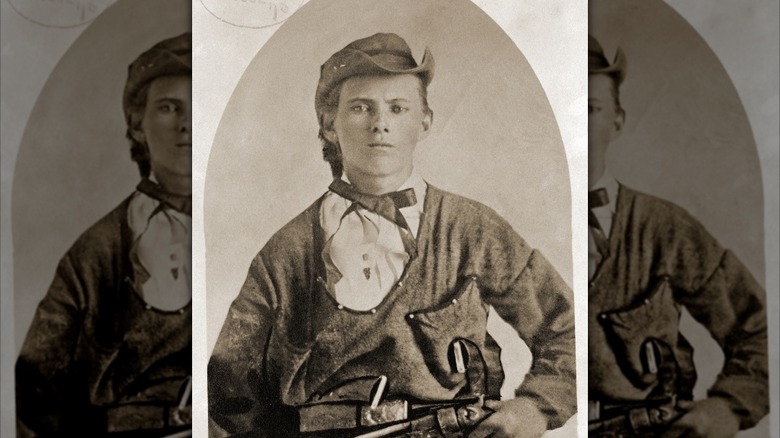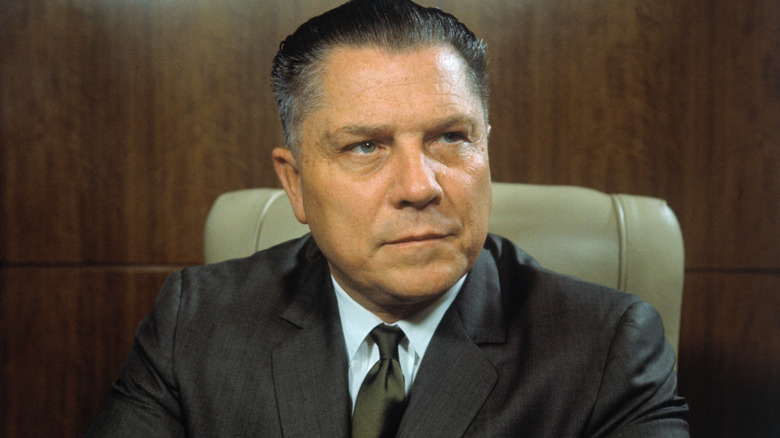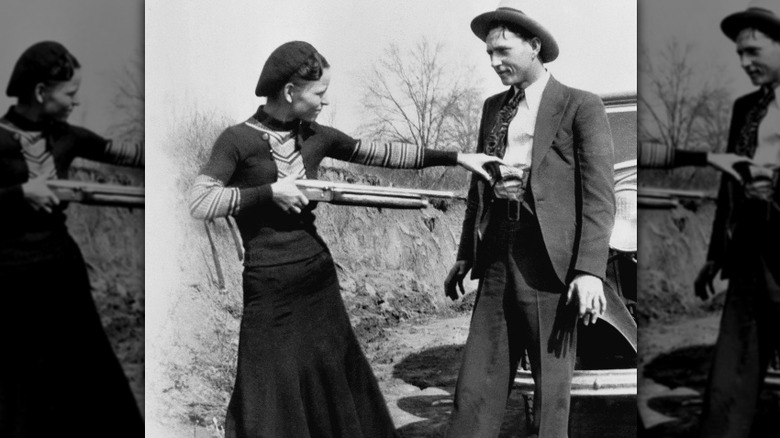What Happened To The Bodies Of These Gangsters?
Those who live by the sword die by the sword. This biblical wisdom might more aptly apply to organized crime if one replaces "sword" with "gun." This may be true of many lower-ranking organized crime figures and gangsters — the guys who never make it to the top. But for the kingpins, it often does not apply.
Among American organized crime, the top people have often died peaceful deaths. In fact, New York Cosa Nostra's biggest dons are all buried in a handful of cemeteries in Brooklyn and Queens, in many cases having received Catholic funerals and burials. The same can be said about Al Capone or Meyer Lansky. All in all, the stories of what happened to their bodies are noteworthy precisely because they are so typical and boring.
But not everyone had a peaceful death. Outlaws like Jesse James and Bonnie and Clyde met more expected violent ends, in the latter case, ending up as exhibition props in their hometowns. And then of course, there is Jimmy Hoffa, whose body has never been found.
Alphonse Al Capone
Al Capone, American mafia's OG, was a mobster who never saw justice or served a day in prison for bootlegging, extortion, prostitution, or the numerous murders (likely including the St. Valentine's Day Massacre) in which his syndicate was implicated. The IRS only finally got to him for tax evasion and failure to declare criminally obtained income, for which Capone did 11 years. He got out after seven on compassionate release due to neurological complications from syphilis, but was left with the mental capacity of a 12-year-old. He died of a stroke in Florida in 1947, a quiet death for someone who lived such a violent life.
Capone's body was dressed up for his wake in Miami, where well-wishers paid their respects — preferably anonymously, as almost everyone outside of close family preferred to enter through the morgue's back door. Louis Rago, the son of the Chicago funeral home owner who oversaw Capone's funeral arrangements, told the Chicago Tribune the body was transported without much fanfare to Chicago's West Side, promptly moved to a church for a funeral Mass, and buried in the city's Mount Olivet Cemetery with as little fanfare and as few associates as possible — only family and close friends. The press was barred from the event.
In the 1950s, Capone's body was moved to its current resting place at Hillside's Mount Carmel Catholic Cemetery, although the reasons for doing so are kept private out of respect to the family, Catholic Cemeteries of Chicago said in a statement to the Chicago Tribune.
John Gotti
John Gotti earned himself the nickname the "Teflon Don," for skating on two different raps in two of American legal history's most disastrous criminal trials. Law enforcement eventually caught up with him in 1992, when he was sentenced to life in prison for killing his old boss, Gambino don Paul Castellano. Gotti died in federal prison in 2002 from throat cancer.
Gotti's body was laid to rest with full pomp and circumstance. The don's funeral procession involved 300 people, 100 cars, including black limousines and over 24 flower cars. Gotti was buried in Queens' St. John's Cemetery next to his son Frankie, who died after being run over by a car at age 12.
Despite the outpouring of support from Gotti's associates and family, the event was marred by the family's conflict with the Catholic Church. The Church denied Gotti a funeral Mass on the basis that he was an unrepentant public sinner. Unnamed sources told the New York Post that Gotti may have repented and received absolution while in prison. The Federal Bureau of Prisons, however, refused to say whether he had met with a Catholic chaplain. Furthermore, since Catholic priests have to follow a rule called the seal of confession, even if Gotti had repented, the priest would not have been allowed to even say whether Gotti had confessed. Without any clear evidence of repentance, Bishop Thomas Daly of Brooklyn had no choice but to deny the family's funeral request.
Maier Suchowljansky (aka Meyer Lansky)
Murder, Inc. and Prohibition-era heavyweight Meyer Lansky would have preferred to be buried in Israel, especially as the heat from Uncle Sam was turning up over unpaid taxes surrounding his gambling empire. Lansky, who was Jewish, was a strong supporter of the Jewish state. But despite his devotion, the Israeli government did not reciprocate, voiding his right of return on the grounds he was a national security risk. He settled for Miami, where he died of lung cancer in 1983 at 81, having served a mere 40 days in prison over a nearly seven-decade criminal career that began as a teenager in the late 1910s.
Lansky's funeral was a very modest and subdued affair, because, despite claims of having stashed up to $400 million, in reality, the gangster had fallen on hard times. Rather than living the life of luxury that many other organized crime figures enjoyed in Florida, Lansky lived in a condo in a retirement community that the Jewish Telegraphic Agency described as a "boulevard of long-faded elegance on this island resort which has become a refuge for elderly Jews." His funeral, presided over by Rabbi Semaryahu Swirsky, was a mere 15 minutes and featured only a handful of family and friends from the area. After that, his body was buried in Miami's Har Nebo Cemetery in a simple grave commemorated only by a small slab, bringing the life of one of America's most notorious gangsters to a quiet close.
Bernardo Provenzano
Bernardo Provenzano's life is one of those Mafia stories that seems too wild to be true – yet it is. The Sicilian boss ran his outfit from a derelict farm with two typewriters and a handful of Bibles, using ciphers and code to send out hits — allegedly by having his opponents run over with tractors. He died in 2016 near Milan while serving a life sentence for the killings of Italian anti-mafia officials.
Provenzano's funeral was complicated because in Italy, mafia funerals tend to bring out all sorts of local well-wishers, much to the chagrin of the Italian state. There was also the issue of whether he would receive a Catholic funeral, despite his criminal history. Italian police allowed a public funeral, but forbade any sort of procession that would give the locals of Corleone, Sicily, the opportunity to honor the boss. Instead, Provenzano got a funeral Mass attended by close family and friends, and was buried in a family plot without any reference to the life he lived.
Meanwhile, the Catholic Church came under intense criticism for allowing the funeral. Critics noted that Pope Francis had told mobsters they were excommunicated from the Church and would end up in hell unless they repented of their ways. Provenzano definitely seemed to fit the bill — assuming he never repented while in prison.
Salvatore Lucania (aka Charles Lucky Luciano)
Neapolitan-born bootlegging kingpin of the Prohibition era, Lucania lived a colorful life. The mobster served his country by laying the groundwork for the U.S. Army's 1943 invasion of Sicily — Operation Husky — in return for running his criminal network from prison. For his assistance, the feds sprung him from prison in 1946 and deported him to Italy, where he died in 1962 after meeting with filmmaker Martin Gosch. Gosch wanted to make a biography of the gangster, and met him at Naples' Capodichino International Airport. After the meeting, Lucania suffered a heart attack.
While in Italy, Lucania had complained about missing the United States, particularly New York City, which he had come to consider his home — unsurprising since he had lived in the U.S. since he was a young boy. He wanted to be interred in the United States in the family mausoleum he had purchased for his parents, an aunt, and an uncle. Thus, he received a Catholic funeral before his body was flown to New York for a modest, unceremonious burial. Only two of his brothers turned up to receive the body.
Despite the small turnout, Lucania still got a procession, although a very different one from the usual fanfare around mob funerals. The funeral procession was made up of 25 cars. A single one carried the mourners. The other 24 were journalists and federal law enforcement from various agencies, who were there to ensure the funeral did not become a setting for illicit dealing.
Arthur Flegenheimer (aka Dutch Schultz)
A lesser-known but no less ruthless Prohibition-era mobster, Flegenheimer was feeling the heat in 1935 from New York prosecutor Thomas Dewey over racketeering crimes. Flegenheimer proposed killing Dewey to Murder, Inc. head Albert Anastasia. But he forgot a cardinal rule of organized crime: only kill government officials when absolutely necessary. Anastasia refused. Fearing Flegenheimer would kill Dewey himself and bring the long arm of federal enforcement upon New York's gangland scene, Anastasia had Flegenheimer and three bodyguards sprayed with bullets in Newark, New Jersey. Flegenheimer, however, survived.
As it became clear he would likely not survive surgery, Flegenheimer, who was Jewish, had a crisis of conscience and decided to convert to Catholicism. A hastily summoned priest gave Flegenheimer the sacraments, and he died soon afterward. Although his last-minute repentance raised some furor, Catholic circles noted at the time that if Flegenheimer was serious about conversion and repentance, there was no turning him away.
Flegenheimer was buried in a small, secret Catholic ceremony before sunrise attended by only five people: his mother, sister, wife, and two other men. Although he received a Catholic burial, his Orthodox Jewish mother requested he be buried wearing a Tallit — a Jewish prayer shawl — as a homage to his origins.
Carlo Gambino
When it comes to the title of America's most famous mobster, Carlo Gambino certainly gives Al Capone a run for his money, being the man who came closest to becoming the boss of all bosses of New York's La Cosa Nostra. Over the span of nearly 50 years, he served less than two years in prison on tax charges related to bootlegging, and even avoided deportation to Italy over illegal entry to the U.S. in 1921 thanks to his health problems. He died peacefully on Long Island, New York, in 1976.,
Gambino's funeral was not the grandiose funeral filled with tributes from members of Cosa Nostra that one would expect for one of New York's most powerful men, mostly because his family kept it on the smaller side, as he would have wanted. Only about 350 people attended the funeral, the vast majority of whom were friends, relatives, and neighbors — not fellow gangsters, although there were some black limousines as part of the funeral cortege. So many people showed up — including large numbers of federal agents — that Gambino's people had to turn many well-wishers away at the door. Among the most expensive parts of the ceremony was probably the $7,000 coffin in which the Cosa Nostra kingpin was laid to rest.
After the funeral, Gambino was laid to rest in St. John's Cemetery in Queens, where he remains today.
Heriberto Lazcano
Heriberto "the Executioner," Lazcano was one of Mexico's most feared cartel bosses and founder of the Los Zetas cartel. Under his leadership, the cartel bombed a Mexican Independence Day celebration in 2008, and murdered 300 people in a single massacre in the Mexican town of Allende in 2011. Mexican federal forces killed him in a shootout in 2012, but his body's journey was far from over.
When Lazcano was killed, Mexican forces were not aware they had killed him. The Mexican Navy, however, had his biometrics on file, and was able to confirm using fingerprints that the body was indeed his. Once Zetas fighters, however, found out about their leader's death, they stormed the morgue and took the body — a last-ditch attempt to deny the Mexican government the opportunity to parade his body as a trophy of the drug war.
Officially, the body disappeared and has not been seen since. However, the drug boss had built himself a large mausoleum in his hometown of Pachuca, in the neighborhood of El Tezontle, where he also funded the Church of St. Francis and the John Paul II Center for Evangelization and Catechesis. This is one possibility, although Mexican military personnel interviewed in La Silla Rota maintain that he no longer has family in the area and is thus unlikely to be buried there.
Jesse James
Ex-Confederate guerrilla-turned-outlaw for the Southern cause, Jesse James' death was a bit of a tragedy — he was shot and killed by members of his own gang on the promise of a $10,000 reward. As the two shooters escaped prison with a pardon from Governor Thomas Crittenden of Missouri, James' mother, Zerelda, was left to bury her son.
Zerelda James buried Jesse on the family farm near Kearney, Missouri, where he and his brother had grown up. But the late 19th and early 20th centuries were a time of circuses and grisly displays of souvenirs from the dead. The bodies of outlaws in particular attracted morbid public curiosity, so Jesse James Jr., the outlaw's son, decided to properly rebury his father in Kearney's Mount Olivet Cemetery. The body remains there today.
At least, that is the official account of James' death and burial, but his legendary status spawned a handful of other tales regarding his death, most famously in Granbury, Texas. Local legend recounts that the two assassins killed the wrong man — another member of James gang — rather than the outlaw himself, who escaped to the Lone Star State. He reportedly married a local Texas girl and died peacefully, living out his last days in the town that still marks his alleged presence with a memorial stone in the local cemetery. Who donated the stone? Allegedly none other than James' own family, who believed he really had escaped.
Jimmy Hoffa
While not technically a gangster, Jimmy Hoffa's questionable 13-year tenure as president of the American Teamsters Union was filled with mob connections. His activities landed him 13 years in the slammer on mail fraud, jury tampering, and graft charges, but Richard Nixon commuted his sentence in 1971. Instead of quitting while he was ahead, however, Hoffa went straight back to his old ways — and it cost him his life.
Hoffa disappeared, practically without a trace, on July 30, 1975, on his way to Detroit. The official account has him meeting "friends," in Pontiac, Michigan, who in reality, were probably associates — mobsters Anthony Giacalone and Anthony Provenzano. He called his wife to tell her neither showed up, and then was never heard from again.
So what about the body? All that is known with absolute certainty is that Hoffa got into a car belonging to former friend and associate Charles O'Brien, who had apparently fallen out with Hoffa. The FBI found a strand of hair that DNA testing confirmed was Hoffa's in 2001, but was unable to say much more — claims he had been shot were disproved by DNA testing, leaving police with two possibilities. Either the body was buried somewhere and it is yet to be found, or the killers dissolved it in acid, leaving no remains for law enforcement to find.
Bonnie Parker and Clyde Barrow (aka Bonnie and Clyde)
If Jesse James ranks as America's best-known individual outlaw, then Bonnie Parker and Clyde Barrow are American crime's royal couple — despite never being married. Between 1930 and 1934, their gang committed around 13 murders and numerous robberies, specializing in robbing banks and stealing cars. Their tendency to drive stolen cars across state lines gave the FBI the evidence it needed to issue warrants for their arrest. Texas Rangers, FBI agents, and Louisiana state police eventually caught up to them in Arcadia, Louisiana, and sprayed them with gunfire in a 1934 road ambush — 167 times to be exact.
The police ambush completely shredded the bodies, whose condition was captured on film in a 1934 newsreel. Souvenir hunters then took parts of their hair and skin, mutilating them ever further. The bodies were taken to the Arcadia Funeral home and put on display, where over 70,000 people turned up to view the bodies, reportedly to make sure the outlaw couple was really dead.
The bodies were eventually sent back to Dallas, where the pair had originally met. Clyde was buried in Dallas' Western Heights Cemetery next to his brother. Bonnie would have liked to be buried with him, but she was instead interred at the Fish Trap Cemetery, before vandals forced the body's removal to Crown Hill Memorial Park, where it rests today. The saga is not over, however, as the pair's relatives have been fighting for their bodies to be reunited in death.
